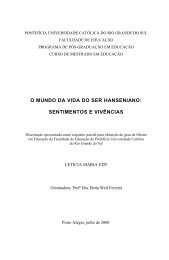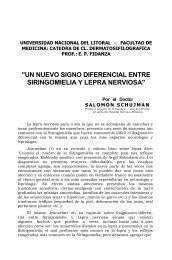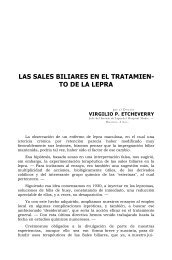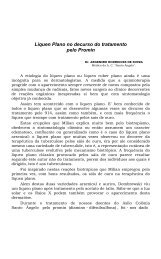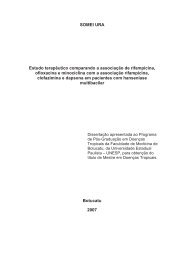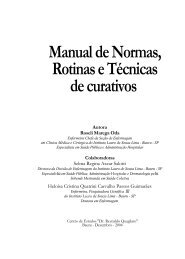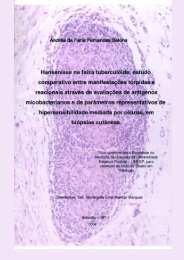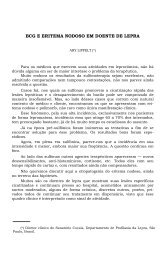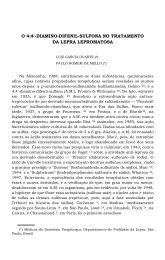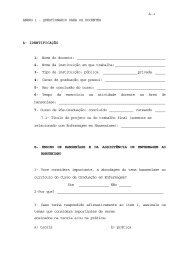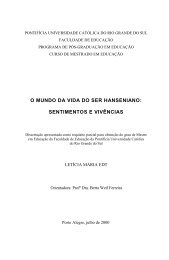INTERNATIONAL JOURNAL OF LEPROSY - Index of
INTERNATIONAL JOURNAL OF LEPROSY - Index of
INTERNATIONAL JOURNAL OF LEPROSY - Index of
You also want an ePaper? Increase the reach of your titles
YUMPU automatically turns print PDFs into web optimized ePapers that Google loves.
69, I^Trama,/ and Kraltenbulil: M. leprae Viabllity^ 9<br />
association with MFP results '8). In addition,<br />
FDA-EB staining lias not proveu to<br />
be ellective for in varo drug susceptibility<br />
testing, and M. /eprae may requ ire in vivo<br />
incubation before viability differences can<br />
be noted with this procedure.<br />
Other biochemical assays also may be<br />
useful for indexing 1W. leprae viability.<br />
Some studies have suggested that the relative<br />
concentrations <strong>of</strong> ATP among M. lepme<br />
is broadly associable with the likelihood<br />
that they may eventually manifest detectable<br />
growth in the MEI). However, the<br />
specitic cellular concentration <strong>of</strong> ATP required<br />
has not been standardized, and the<br />
assay is not known to discern suhtle differences<br />
in viability (3(1• Similar to palmitate,<br />
the uptake <strong>of</strong> hypoxanthine by M. leprae<br />
axenie cultue is reported to be useful for in<br />
vin.() drug screening. However, its use as a<br />
quantitative index <strong>of</strong> viability was discounted<br />
early on because hypoxanthine incorporation<br />
appeared to increase continuously<br />
even among relatively old M. leprae<br />
suspensions with declining viability (21)•<br />
Palmitate oxidation assays show a broader<br />
range <strong>of</strong> activity than hypoxanthine and require<br />
considerably fewer bacilli ( 105' compared<br />
to 108). However, some culture systems<br />
also can erroneously suggest that<br />
palmitate is metabolized continuously by<br />
aging M. leprae suspensions.<br />
Oxidation <strong>of</strong> '4C-palmitate in axenic cultue<br />
results in the evolution <strong>of</strong> radiolabeled<br />
CO„ which can be detected in a number <strong>of</strong><br />
different ways. When using the BACTEC<br />
460 instrument, the respiration index for M.<br />
leprae in culture rises rapidly during the<br />
first 7 days to a plateau which is sustained<br />
for another 2 weeks. However, the actual<br />
viability <strong>of</strong> M. leprae in these aging cultures<br />
continues to decline. Therefore, the<br />
third week GI <strong>of</strong> BACTEC cultures correlates<br />
very poorly with the MFP results <strong>of</strong> M.<br />
leprae suspensions <strong>of</strong> this age. Interestingly<br />
though, when those stored M. leprae suspensions<br />
are subcultured they show a similar<br />
activity panem in BACTEC; rising<br />
rapidly for 7 clays to a plateau that is sustained<br />
for another 2 weeks. The peak GI<br />
achieved by those aged subcultures, however,<br />
is markedly lower than the peak<br />
achieved by their fresh counterparts. The<br />
lower peak <strong>of</strong> the stored cultues is consistent<br />
with the lower viability uí the aged or-<br />
ganisms. With BACTEC, the peak GI is<br />
highly correlated with the suspension's<br />
MFP growth results. The second and third<br />
week plateau GIs appear to be just an artifact<br />
<strong>of</strong> the BACTEC 460 culture system.<br />
Buddemeyer-type (biphasic) culture systems<br />
also show a 7-day peak in oxidative<br />
metabolism <strong>of</strong> '3C-palmitate by M. leprae.<br />
BACTEC and Buddemeyer RR results are<br />
highly correlated, both individually and<br />
with MET. Therefore, the rate that a substrate<br />
is metabolized by M.1(1»-ae in axenic<br />
culture may be far more important in terms<br />
<strong>of</strong> viability than its apparent duration orlotal<br />
uptake.<br />
Supplies <strong>of</strong>M. /eprae used in experimental<br />
studies are usually propagated in either<br />
nude mice or armadillos. These hosts serve<br />
different roles in propagation and the leprosy<br />
bacilli become manifest in their tissues<br />
by different routes. Nude mouse-derived M.<br />
leprae tend to show higher RR activity than<br />
M. leprae obtained from armadillo tissues.<br />
Armadillos yield hundreds <strong>of</strong> times more<br />
M. leprae than can be derived from a nude<br />
mouse, and they are harvested only after a<br />
long incubation period in the latest stages <strong>of</strong><br />
experimental leprosy in order to obtain<br />
those maximum bacillary yields. M. leprae<br />
infections <strong>of</strong> nude mice are more easily<br />
scheduled and controlled, and nude mice<br />
can be a good source for small quantities <strong>of</strong><br />
highly viable M. leprae. However, the viability<br />
<strong>of</strong> nude mouse-derived M. lepme also<br />
varies markedly. M. /eprae taken from nude<br />
mice in very late stages <strong>of</strong> experimental infection<br />
or derived from very large or ulcerated<br />
foot pads also show low viability.<br />
Therefore, the intended use <strong>of</strong> the bacilli really<br />
dictates what propagation method is<br />
most appropri ate.<br />
The quality <strong>of</strong> viable M. leprae as a research<br />
reagent is markedly intluenced by<br />
storage conditions and incubation temperatures.<br />
We and a number <strong>of</strong> other investigators<br />
have observed that without regard to<br />
the storage conditions used. M. lepme suspensions<br />
lose nearly all <strong>of</strong> their detectable<br />
metabolic activity and a signilicant proportion<br />
<strong>of</strong> their total viability within 3 weeks <strong>of</strong><br />
harvest from host tissues. A similar degree<br />
<strong>of</strong> loss is incurred within just hours if the<br />
bacilli are incubated at 37°C or frozen even<br />
a siagje time (2. 12. 16. 17,. ) These lindings<br />
can bring into question the conclusions



